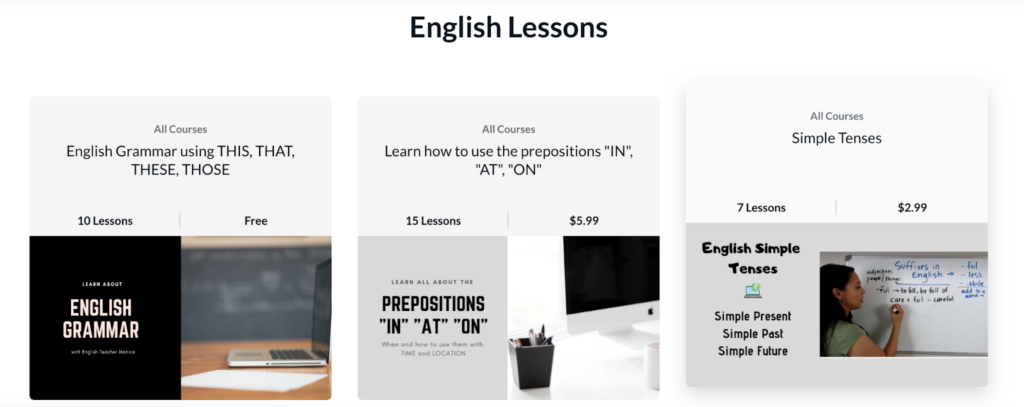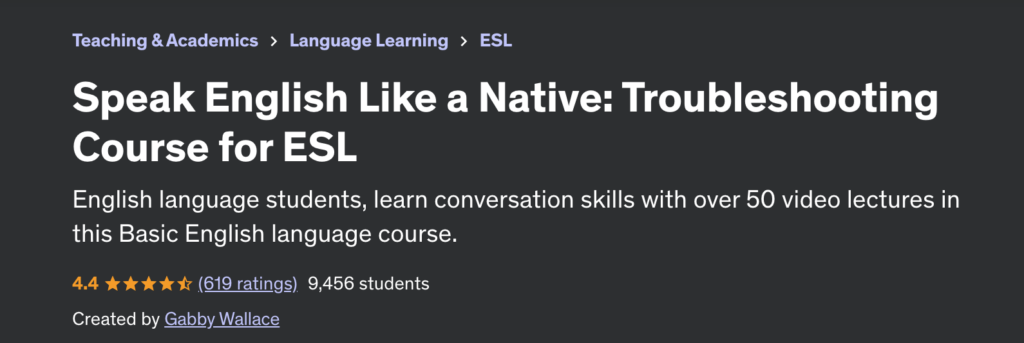As a fellow online English teacher, one of the first thoughts that popped into my mind when deciding if I should pursue teaching a language online was: “How on earth am I supposed to teach English to non-native English speakers if I don’t know their language?”
Before we go any further, rest assured that you don’t need to speak any other languages in order to successfully teach English online, as I quickly discovered.
A few years back, I had received my TEFL certificate (more on what this is later), and was prepared to pack my bags and move halfway across the globe to teach English abroad… However, life got in the way (as it has a habit of doing) – so my grand plans to reinvent myself as an English teacher were halted.
Afterwards I soon realized that I didn’t need to relocate myself in order to teach English because there was a much more profitable option right in front of me – teaching English online!
Teaching a language online has never been easier – and more in demand. The rapidly growing market for online language learning is predicted to reach a jaw-dropping $38.7 billion by the year 2030! That’s right, now is the best time to dust off your language skills and dive headfirst into the ultimate side-gig that allows you to make some extra cash from anywhere in the world.
Now more than ever people are looking to improve their English by connecting with native-speaking English teachers, especially from the comfort of their own home and country.
And don’t worry if you don’t think you’re qualified enough to teach English to other people – we’ll go into depth on all the credentials you need to teach English online, and you’ll be surprised by how easy it is!
In this guide below, we’ve collected all the essential tips and tricks to get you started on this exciting new journey. Jump around or follow along for everything you need to know about teaching English online:
- What are the benefits of teaching English online?
- Qualifications and skills for teaching English online
- Choosing the best platform to teach English online
- Effective teaching methods for online English classes
- Setting up your virtual classroom
- Examples of teaching English online
- Make an impact teaching English online
Related: How to Build a Personal Brand (Complete Guide)
Now, without further adieu let’s get started!
 Photo: Unsplash
Photo: Unsplash
What are the benefits of teaching English online?
Imagine working for 2-3 hours each day and then filling up the rest of your time with passion projects, a little R&R, or with other side hustles (workaholics, we see you)… the best part about teaching English online is that it gives you the freedom to enjoy a flexible schedule that is maintained by YOU!
A major benefit of getting an online teaching gig is that it offers a sustainable income that allows you to choose what kind of lifestyle you desire – whether it’s working on the road or from a home base, teaching English online opens the door to all the possibilities that come with choosing your own work lifestyle.
While the personal benefits of this profession are great, it also fulfills the need for human connection and allows you to make a positive difference in the world, impacting the lives of those eager to learn another language.
Shereen Jaff, one of the creators in our community, sums it up best:
“I’ve had students who have never before taken an online course in a group setting… Using Thinkific to teach English to my students online has completely transformed their fear of speaking English in front of others. Never underestimate the power of community!”
Some other perks to this job include no minimum or maximum working hours, deciding on your own availability, lesson plans and teaching materials are often provided, the ability to teach from anywhere in the world, small or private class sizes, the potential to earn a good paycheck, and lastly that you don’t need a degree to teach English!
How to make money with online classes
As we mentioned, the demand for online English teachers is greater than ever before – In 2023, there were approximately 1.5 billion people worldwide who spoke English, that’s about one in every four of us, either natively or as a second language.
English is a global language that is one of the fastest-spreading languages in human history – which means that with more and more people wanting to learn English everyday, teaching English can be easily monetized upon.
While some people teach English online as a side hustle to supplement their income, there are ample opportunities to make a full-time living – if you have the ambition. Those willing to put in the time and energy to build up their online learning platform stand to reap the rewards in this industry that has been rapidly growing for years.
Given the flexibility of the profession, you can expect to earn anywhere between a couple hundred dollars per week or upwards of a few thousand, depending on whether you work casually, part-time, or full-time with this gig.
As an online English teacher creating your own course, how much you charge will depend on a number of factors, such as:
- How much experience you have
- What your qualifications are
- If you work for an online teaching company or independently
- What kind of lessons you are teaching (tutoring or lesson-based)
Once you get into a groove with teaching, you’ll be able to raise your prices. It’s quite simple to know when it’s time to do this – if you find that you’re filling up all your lesson slots each week and have to turn students away, then you’re in a position to consider raising your rate.
Related: How to Price Your Online Course (Complete Guide to Course Pricing)
Qualifications and skills for teaching English online
Now that we’ve piqued your curiosity, let’s go over the qualifications and skills you’ll need to have handy in your tool belt to pursue teaching English online.
Remember when I mentioned that you may be more qualified to teach English online than you think? Well, it still holds true!
First – no surprise here – you need to speak English fluently! Ideally, you’ll need to be native English speaker, but also being seamlessly fluent can work too as long as you have been proficient for a number of years.
Second, you don’t need to have any sort of degree to teach English online. While having a degree isn’t necessarily required (although it definitely can help having one), most companies do expect you to have some kind of TEFL certificate.
TEFL stands for Teaching English as a Foreign Language, and this course provides you with the training and qualifications that you need to get a job teaching English online. It is also commonly known as Teaching English to Speakers of Other Languages (TESOL), English Language Teaching (ELT), and teaching English as a Second Language (ESL).
And lastly, you’ll need to have a passion for learning and helping others! It’s simple enough to learn the other skills necessary for teaching, such as classroom time-management skills and organizational skills, but having the motivation to actually want to teach others will make this fun as well.
Online TEFL courses

TEFL courses are typically around 120 hours long (with options for add-ons) and are go-at-your-own pace, which means it could take you as little as a couple weeks to complete or a few months.
While a TEFL certificate isn’t mandatory to teach English online, most reputable companies do require this certificate. Also, given that the job market is becoming more competitive, you’ll want to stand out amongst your competition, a.k.a. those who will most likely have a TEFL teaching certification.
There’s a LOT of online TEFL courses available that you can take and get certified in no time from home. In fact, it can be overwhelming to choose one, so we’ve provided this list of some top contenders:
- Best overall: International TEFL Academy
- Best online program: Premier TEFL
- Best budget-friendly option: ITT
- Best for student support: TEFL Org
- Best hybrid program: ITTT
- Best for specializations: Teach Away
- Best for overseas job placement: TEFLPros
- Best for online teaching: i-to-i
I did my course with Teach Away (which I highly recommend for an easy user-experience), but any of these options would be great to kickstart your teaching journey.
Related: How to Teach Mathematics Online: A Comprehensive Guide
Choosing the best platform to teach English online
Working for an online teaching company is the best way to dip your toes in the water if you don’t have any experience teaching English online. If you start out solo, at first it can be challenging and time-consuming to source students as an independent online teacher. The nice thing about working for an online teaching company is that they are bringing in the clients, and many will also provide all of the lesson materials as well, saving you hours of work on lesson planning.
Once you get the hang of teaching English online and have built up a rapport with some clients, building up your own business as an independent teacher is a great way to maximize your earnings. Or, if you’re feeling ambitious you can skip the first step and jump right into building your very own online course to jumpstart your English teaching career.
The first step to building your online teaching business from the ground up is finding a reliable and secure platform to create an online course through.
There are lots of different features to consider when picking the best platform for online teaching. Luckily for you, we’ve done all the hard work so that you don’t need to spend time sifting through the various platforms out there.
Here is a list of some of the best online teaching platforms to choose from:
| Platform | Pros | Cons |
| 1. Thinkific |
|
|
| 2. Podia |
|
|
| 3. Kajabi |
|
|
| 4. LearnDash |
|
|
| 5. WizIQ |
|
|
Related: 10 Steps To Creating A Wildly Successful Online Course
Effective teaching methods for online English classes
Now that you’ve secured a teaching platform to host your online English course, let’s go over some tactics to keep your students engaged and have those course referrals rolling in.
The key to having a strong presence online as an English teacher is to establish a positive connection with your students right off the bat.
If your online course is live, this is much easier to do as you are able to interact with your students in real-time. This is also true even during a synchronous remote learning course, as the teacher is visible on camera, and students are able to ask questions or raise their virtual hand like they would in a face-to-face classroom.
However, during self-paced, asynchronous learning, connecting with your students can become more difficult. You may not be in the same time-zones as your students, and even when you are online at the same time as your students they might not be aware of this.
When your online teaching business is based on student satisfaction, you’ll want to be as present as possible for your class!
Some ways to create a strong online teaching presence include:
- Offer live teaching sessions. This can include breakout rooms, office hours, and homework help. Let your students know that you’re available to meet with them and provide assistance.
- Facilitate introductions and build a community. Post a video at the top of your main online classroom page introducing yourself to the class. Also design opportunities for students to mix and get to know each other, such as collaborative learning activities.
- Provide regular, clear communication. As much as you can, connect with students individually – this goes a long way in showing you care. Provide clear expectations and directions, using videos when possible, to increase engagement and understanding.
- Offer feedback for online work. Frequent feedback on assignments, discussions, and projects will let students know if they are on the right path. It also shows them that their work matters to you and that you want them to succeed.
- Personalize the course. Students often remember how they were treated by a teacher or how they “felt” about a class even more than the topic they learned. As much as you can, bring your personality into your remote classroom. Celebrate accomplishments, use online class bulletin boards for announcements, and let it be a fun and inviting space to be.
Keeping your students engaged requires effort and for you to be actively engaged yourself, however it pays off in the long run.
Having a positive online presence and engaging your students go hand-in-hand. Both help with providing clear lines of communication for your class, offering support and guidance when needed, giving academic feedback to inform learning, and facilitating and modeling learning.
When teaching English to non-native English speakers online, you will most likely be creating lessons that cover basic vocabulary, simple sentence structures, and grammatical patterns. However, that doesn’t mean you can’t add your own personal touch!
Personalizing your lesson plans is one of the best ways to keep your students engaged. A few ways to do this include:
- Plan for short attention spans with bite-sized learning activities
- Address different learning styles and multiple intelligences by offering options for students to choose from
- Switch up lessons designs often by adding musical components, puzzles, or investigations that target key learning objectives
- Turn lessons into games or stories to help with remembering by engaging the emotional and logical areas of the brain
Remember, you can always switch up your lesson plan if you are noticing a lack of engagement from your students. Better yet, conduct a class survey to find out your students’ learning preferences and what they would like to see in the lessons. As a new teacher, this will help you gauge where you are at.
Like any teacher, you want your students to succeed. Think about how you want to evaluate your students’ progress in your class – remember to consider the level and ability of your students when deciding how they will be assessed.
It’s important to establish clear learning outcomes for your lessons, and have your assessments target these learning outcomes to ensure that your students are focusing on absorbing the correct material.
Common ways to measure student progress online include:
- Open-book quizzes or tests
- Writing assignments
- Case studies
- Weekly homework
- Discussion posts
- Group research projects
As you will most likely be teaching English to beginners who are learning English as a second language, you will want to make sure your material, lessons, and assessments are straightforward and easy for non-native English speakers to digest and understand.
Pro tip: Avoid using complex jargon and big words when creating your lesson plans!
Related: What Is Universal Design For Learning? (Examples & Best Practices)
Setting up your virtual classroom
Now that you have most of your bases covered when it comes to learning how to teach English online, let’s get to one of the most important parts of starting your own course: how to market your online English course.
How to market your online school
You could have the best online English course out there, however if you don’t know how to advertise it, you’ll find yourself missing the key ingredient to a wildly successful online course: students!
To attract students to your course (and keep them coming back), we’ve put together a list of some of the best marketing techniques you can easily implement to promote your online English course:
- Social media marketing. Establish your online presence by selecting one or two platforms to focus on, and start creating social content that engages your target audience. Once you master one platform, move on to the next. Instagram and Tiktok are great starting places to widen your reach.
- Email marketing. This provides you with a direct link to your target audience, and allows you to foster a connection with them. You can do this by offering gated content like ebooks, how-to guides, or webinars. We recommend using a tool like Mailchimp to simplify things.
- Ads and sponsored posts. This is a great way to bring visibility to your course – especially when targeting potential students in different countries as paid ads can promote your course at a quicker rate.
- SEO techniques. Search engine optimization makes your content easy to find online – so it’s worth the hassle to learn about it. SEO often includes keyword research, on-page SEO elements (meta description and headers), off-page SEO (backlinks), and technical SEO (site speed and mobile optimization).
- Word of mouth. As your business picks up steam, you’ll find the word will spread and students will refer you to others. This is something that’ll happen naturally as long as you continue offering high-quality content that stands out from your competitors.
Examples of teaching English online
In case you need an extra nudge on why you should take the leap and become an online English teacher, here are some examples of people who have real-life experiences to inspire you.

Meet Monica
Monica has set up her very own online English course through Thinkific, and offers a range of lessons and video-based instruction that help students with simple tenses, prepositions, and grammar with her easy-to-use platform. She offers free previews for her lessons and an outline of the curriculum and assessments that are included. You’ll also complete this course by receiving a certificate from the English teacher herself.

Meet Nic
For Nic, teaching English online is a huge part of her life. She had first heard about it from her friend who was teaching little kids in China early in the mornings online – and she saw how adorable it was. Nic loves kids, and so she thought, why not? It’s been three years since her first virtual class and she is happy to admit that she still enjoys online teaching. She loves having a flexible schedule, a 5-second commute, and pre-made lesson plans. Nic says that the best part about teaching English online is that it lets her focus 100% on working with the students one-on-one.

Meet Gaby
With almost 10,000 students, Gabby is the founder and a teacher at Go Natural English. This is a popular YouTube channel and website that helps intermediate English language learners from more than 130 countries become fluent and confident English speakers. Gabby also offers free lessons on her blog and a complete English course and exclusive community only available through the Go Natural English website. One of her top courses that she offers is “Speak English Like a Native: Troubleshooting Course for ESL” where you can learn conversation skills with over 50 video lectures.
Meet Megan
You may have caught on that I am the author of this blog post… which is one of my many side-hustles I have alongside tutoring English online. So if you’re wondering whether or not you should take the plunge… my answer is YES! Teaching English online and tutoring kids has allowed me to diversify my income, have flexibility in creating my schedule, and set my own working hours. It’s a great addition to my workload, and I love having a positive impact on people’s lives.
Related: How to Make Money Teaching Online (From $100 to $10,000 Per Month)
Make an impact teaching English online
Are you ready to teach English online? Start building a course that’ll leave your students satisfied and coming back for more. With Thinkific, you’ll be able to implement synchronous or asynchronous learning, one-on-one sessions, or an e-Learning experience with Thinkific Mobile that’ll cater to any kind of learning style. Expand your earnings and make a positive difference in people’s lives.
Create and launch your first online teaching course for free using Thinkific today.
This post was originally published in April 2020, it has since been updated on December 12, 2023 to include the most relevant information.






